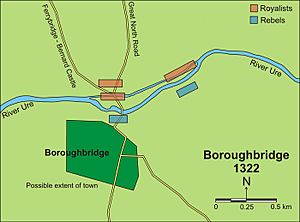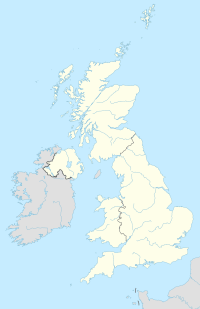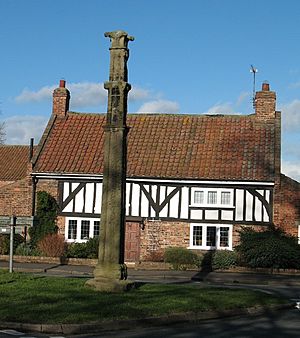Battle of Boroughbridge facts for kids
Quick facts for kids Battle of Boroughbridge |
|||||||
|---|---|---|---|---|---|---|---|
| Part of Despenser War | |||||||
 Map of the battlefield |
|||||||
|
|||||||
| Belligerents | |||||||
| Contrariants | |||||||
| Commanders and leaders | |||||||
Sir John Peche |
|||||||
| Strength | |||||||
| c. 4,000 | c. 1,000 | ||||||
| Casualties and losses | |||||||
| Unknown | Unknown | ||||||
The Battle of Boroughbridge was a fight that happened on March 16, 1322, in England. It was fought near Boroughbridge, a town north-west of York. The battle was between King Edward II and a group of powerful barons who were unhappy with his rule.
The main leader of the rebellious barons was Thomas, Earl of Lancaster. He was the King's cousin and one of the richest men in England. The battle ended with Lancaster's defeat and his execution. This victory helped King Edward II regain control and stay in power for about five more years.
This battle was important for how wars were fought in England. It showed new ways of fighting that had been learned from wars with Scotland. For example, more foot soldiers were used instead of just cavalry (soldiers on horseback). Also, the longbow played a big role, showing how powerful it could be.
Contents
Why the Battle Happened
King Edward II and His Problems
Edward II was not a strong king. Many people thought he was weak, especially compared to his father, Edward I. His time as king was full of military failures and disagreements within England.
Many powerful nobles, called barons, turned against the King. Thomas of Lancaster became their leader. Lancaster was very wealthy and wanted to limit the King's power. He and other barons created rules called the Ordinances. These rules were meant to control the King.
The King's Favorite Advisers
The situation got worse because King Edward II openly favored certain people. His main favorites were Hugh Despenser and his father, also named Hugh Despenser. The King gave them a lot of power and wealth. This made many other nobles very angry.
Growing Conflict and Rebellion
In 1319, the King and Lancaster had a big disagreement during a war against Scotland. Lancaster later refused to attend a meeting called by the King. The King also got permission from the Pope to ignore the rules of the Ordinances.
Meanwhile, a fight over land started in Welsh Marches between the Despensers and some powerful lords, like Humphrey de Bohun. Lancaster decided to support these unhappy lords. He held meetings in 1321 to gather support.
The King was forced to send the younger Despenser away for a short time. But he soon called him back.
The King Moves North
King Edward II then took action. He moved his army north to deal with the rebels. Lancaster tried to get help from Robert I of Scotland. In January 1322, the King's army crossed the River Severn. They made many rebel lords surrender.
Lancaster's army was forced to flee north after the King's army crossed the River Trent. On March 16, Lancaster and his soldiers reached Boroughbridge by the River Ure. They were joined by Sir Robert de Holland, 1st Baron Holand and his men. But they were stopped by the forces of Sir Andrew Harclay, Earl of Carlisle. Harclay was a skilled soldier who had fought in the Scottish wars. He had gathered soldiers from the northern counties.
The Battle of Boroughbridge
Facing the Royal Army
When Lancaster's army arrived at Boroughbridge, Sir Andrew Harclay already controlled the bridge over the river. The rebel army had about 700 knights and men-at-arms. The King's army, led by Harclay, had about 4,000 soldiers.
Lancaster tried to talk to Harclay, but Harclay refused to negotiate. Since there was no other easy way to cross the river, and the King's army was coming from the south, the rebels had to fight. The battle was quick and very one-sided.
Fighting at the Bridge and Ford
Harclay had placed his foot soldiers to defend the bridge. Other soldiers were positioned at a nearby shallow crossing point called a ford. The King's soldiers used a formation called a schiltron. This was a tactic learned from the Scots. In a schiltron, soldiers stand close together with their spears pointing outwards. This formation was very effective against charging cavalry.
The rebels split into two groups. One group, led by Hereford and Roger de Clifford, attacked the bridge on foot. The other group, led by Lancaster, tried to cross the ford on horseback.
The Rebels' Defeat
As Hereford crossed the bridge, he was killed by a pikeman hiding underneath. Clifford was also badly hurt. Their group of soldiers became disorganized. Lancaster's group did not do much better. They faced heavy archery fire from longbows. His cavalry was stopped before they could even reach the ford and had to retreat. This battle showed how powerful the longbow was against cavalry. It was a tactic that would become very important for English armies in the future.
Lancaster then agreed to a truce with Harclay and went back to the town. During the night, many of his soldiers left. The next day, the sheriff of York arrived with more of the King's forces. Lancaster was greatly outnumbered and had no way to escape. He had no choice but to surrender to Harclay.
What Happened After the Battle
The Fate of Lancaster
Thomas of Lancaster was taken to Pontefract Castle, which the King's forces now controlled. There, he had a quick trial. He was sentenced to death in front of many nobles. On March 22, 1322, he was led out of the castle and executed in front of a crowd.
After his death, some people began to see Lancaster as a martyr or even a saint. This might have been a way for people to show their unhappiness with King Edward II's rule.
About thirty of Lancaster's followers were also executed. This included Clifford and John Mowbray. Clifford was executed at York Castle, and a tower there is now named after him.
Andrew Harclay's Reward and Downfall
Andrew Harclay was greatly rewarded for his loyalty and skill at Boroughbridge. He was made Earl of Carlisle and promised a lot of land and money. However, Harclay was not a big supporter of the King. As a warden on the border with Scotland, he became frustrated with the King's lack of action.
Harclay eventually made a peace treaty with the Scots on his own. This was seen as an act of treason against the King. In early 1323, the King's men captured Harclay. He was executed for his actions.
King Edward II's Final Years
King Edward II became even more dependent on the Despensers. Their actions became more unfair. Lancaster's supporters, like Roger Mortimer and Robert de Holland, were often accused of false crimes. They were put in prison, and their lands were taken by the Despensers.
Mortimer eventually escaped to Paris. He was joined there by Edward's wife, Isabella, who had become separated from the King.
In 1327, Isabella and Mortimer led a rebellion against the King. Edward II was removed from power, and his son, Edward III, became the new king.
See also
 In Spanish: Batalla de Boroughbridge para niños
In Spanish: Batalla de Boroughbridge para niños



